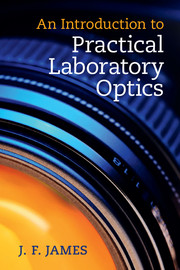Book contents
- Frontmatter
- Contents
- Preface
- 1 Introduction: centred optical systems
- 2 Telescopes and binoculars
- 3 Eyepieces, eyes and colour
- 4 Cameras and camera lenses
- 5 The scientific CCD camera
- 6 Spectrometry
- 7 Interferometers and their uses
- 8 Electro-optical effects and their practical uses
- 9 Microscopes and projectors
- 10 Siderostats and coelostats
- 11 The detection and measurement of radiation
- 12 Practicalities
- Appendix A Gaussian optics
- Appendix B Optical aberrations
- Appendix C A brief introduction to Fourier optics
- Further reading
- Index
4 - Cameras and camera lenses
Published online by Cambridge University Press: 05 October 2014
- Frontmatter
- Contents
- Preface
- 1 Introduction: centred optical systems
- 2 Telescopes and binoculars
- 3 Eyepieces, eyes and colour
- 4 Cameras and camera lenses
- 5 The scientific CCD camera
- 6 Spectrometry
- 7 Interferometers and their uses
- 8 Electro-optical effects and their practical uses
- 9 Microscopes and projectors
- 10 Siderostats and coelostats
- 11 The detection and measurement of radiation
- 12 Practicalities
- Appendix A Gaussian optics
- Appendix B Optical aberrations
- Appendix C A brief introduction to Fourier optics
- Further reading
- Index
Summary
Introduction: the photographic lens
A simple plano-convex lens has one surface plane and the other spherical. Its focal surface is also approximately spherical. The image of a point source at −∞ on the optic axis is never a point because of spherical aberration, and the image is more and more distorted by other aberrations as the field angle increases.
Eighteenth century telescope makers such as John Dollond had discovered these aberrations long before the first photo-sensitive chemical materials were discovered, and they knew that both chromatic aberration and spherical aberration could be corrected (i.e. reduced to a satisfactorily small level) by combining two lenses with spherical surfaces, a positive one made of crown glass and a negative of flint glass, into an achromatic doublet, usually but not always a cemented doublet, in which the second and third surfaces were complementary and the two were joined by a thin film of Canada balsam. This was the first step on a long road which has led to the wide-aperture zoom lenses of current cameras.
A significant milepost on this road was the Gauss achromat, a positive meniscus followed by a negative meniscus: an air-spaced doublet which by its ‘bendings’, i.e. changing the shapes of the elements without changing their powers, reduced the aberrations. It was originally designed by C. F. Gauss at the request of Repsold the Hamburg lens maker, who needed an achromatic telescope objective of improved performance.
- Type
- Chapter
- Information
- An Introduction to Practical Laboratory Optics , pp. 43 - 56Publisher: Cambridge University PressPrint publication year: 2014



